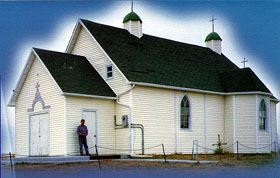

ROMANIANS have been coming to Canada from their magnificent ancestral homeland in central, south-eastern Europe north of the Danube River, west of the Black Sea and the Prut River, and making their home here since the last half of the nineteenth century.
At the centre of Romania and stretching to its northwest is the Transylvanian Plateau surrounded, in the form of an arc, by the Carpathian Mountains which comprise about 30 percent of the entire country. Romania consists of a number of distinct regions, each of which has its own unique history – Walachia, Moldavia,Transylvania, Banat, Oltenia, Dobruja, Bukovina, Crisana, and Maramures.


Gradually, despite the ongoing violence of marauding forces for nearly a thousand years, three distinctive Romanian states began to develop during the Middle Ages: Walachia, Moldavia, and Transylvania. At the end of the sixteenth century A.D., Michael the Brave, a Walachian leader, brought these three Romanian states together under his control. Unfortunately, Michael was soon overthrown and killed. His union of Romanian states collapsed. At long last, in mid-July 1878, the union of Walachia and Moldavia, as the sovereign state of Romania, was recognized internationally through the signing of the Treaty of Berlin by representatives of the Great Powers of Europe and of Turkey.


While the records lack clarity on some matters concerning early Romanian immigration to Canada, other matters are quite clear. When the Treaty of Berlin was signed, it provided, specifically, that the Government of Romania would protect the Jews. But the Jews were not guaranteed Romanian citizenship. By the early 1870s in Canada, however, Jews had the legal right to full Canadian citizenship even though they were often not given equal treatment with Gentiles in particular circumstances. Nonetheless, they did have the right to vote and to be elected to and to hold public offices. In Romania, Jews did not have these rights.
This difference in the legal status of Jews in Canada as compared with their legal status in Romania may have motivated some Romanians to immigrate to Canada. We know from personal and family accounts that Jews immigrated to Canada from Romania before the substantial general immigration began in the late 1890s. It is estimated that, in the last half of the nineteenth century, some 15,000 Jews arrived from Europe as immigrants in Canada. Some settled in southern Saskatchewan and established their own distinctive communities there in the 1890s.


A vigorous campaign by the Government of Canada was responsible for this substantial influx of settlers. The centrepiece of this campaign was the Dominion of Canada Lands Policy. Under that policy, every adult immigrant arriving in Canada’s northwest was entitled to 160 acres of public land – a homestead – on payment of the required fee of ten dollars. The homesteader was required to live on the land chosen, build a dwelling, and cultivate a certain amount of land within a three-year period. If these requirements were met, full title to the home-stead was granted to the homesteader.
This arrangement, whereby an immigrant could acquire land by living on it and working it was attractive to Romanian peasants. They could never have acquired land that way in Romania, but they could in Canada. Thus thousands of Romanians immigrated to Canada in the hope of acquiring land. By 1914 there were more than 8,000 people of Romanian origins living in Canada.


Because of the havoc which had rocked Romania immediately after the war. Like those who came between the wars, immigrants arriving immediately after the Second World War settled, for the most part, in major Canadian cities. Most of them had completed their secondary education and some had completed advanced studies. Despite the difficulties of having, in most cases, to learn a new language and to gain technical and professional acceptance, they were generally successful in securing employment in Canada’s postwar economy. But there were major impediments to be overcome by Romanian-trained medical doctors who came after the Second War and wished to continue to serve in their chosen profession in Canada. These problems still continue.
The violence that accompanied the takeover of Romania by the Communists late in 1947 was another key factor in stimulating the immigration of many thoughtful people. A considerable percentage of the Romanians who came during this phase had spent time in refugee camps in Europe. Romanians who came in the second phase of immigration after the Second World War often faced major perils for themselves and their families since it was often difficult to obtain legal permission to immigrate from Romania. Many Romanians, particularly professionals, were often refused permission to go abroad. For them, Romania had become a prison. Many were determined to escape despite the dangers. Some finally arrived and gained employment in Canada. Others were caught and severely punished. Some lost their lives.


When the first Romanian immigrants arrived in the late nineteenth century, Canada was still, primarily, an agrarian society. Through their work as farmers in Western Canada, Romanians and their fellow immigrants from eastern Europe and else-where helped to develop Canada’s vast agricultural potential. Gradually, through combined efforts, Canada became an agricultural superpower and was transformed into an urban, increasingly mechanized society.
As life in Canada has been and is being transformed through the development and application of increasingly sophisticated technologies and sciences, Romanian specialists have played key roles in many areas. They have contributed to advances in the manufacturing and service sectors of the economy through their skill and knowledge in the automation and now the cybernation of many activities.
Romanians have also played important roles in the development of Canada as a transcultural society. In fact, most Romanians settling in Canada have endeavoured to understand the generally accepted customs and conventions of their neighbours in both English and French language sections of Canada and to adapt thoughtfully to them. Many Romanians can speak both of Canada’s official languages in addition to their mother tongue.
Through the dedication of many individuals working in Romanian churches and synagogues and the various other Romanian cultural agencies, efforts are ongoing to sustain and foster appreciation of historic cultural and moral values in the several Romanian traditions. These activities, which have been carried forward now for over a century by succeeding generations of Romanians who have chosen Canada as their new homeland, have enhanced the quality and the richness of the life Canadians are privileged to share.
D. McCormack Smyth